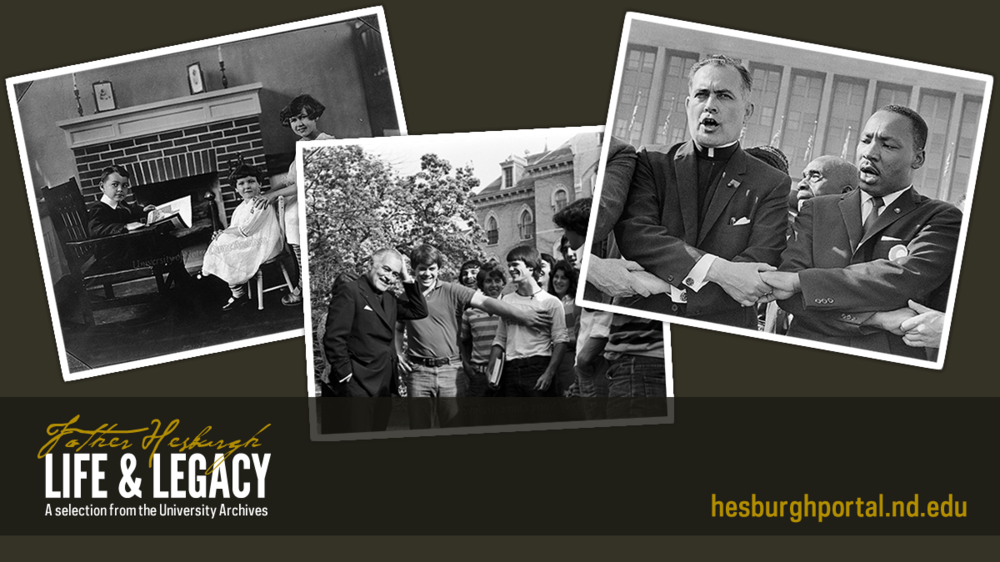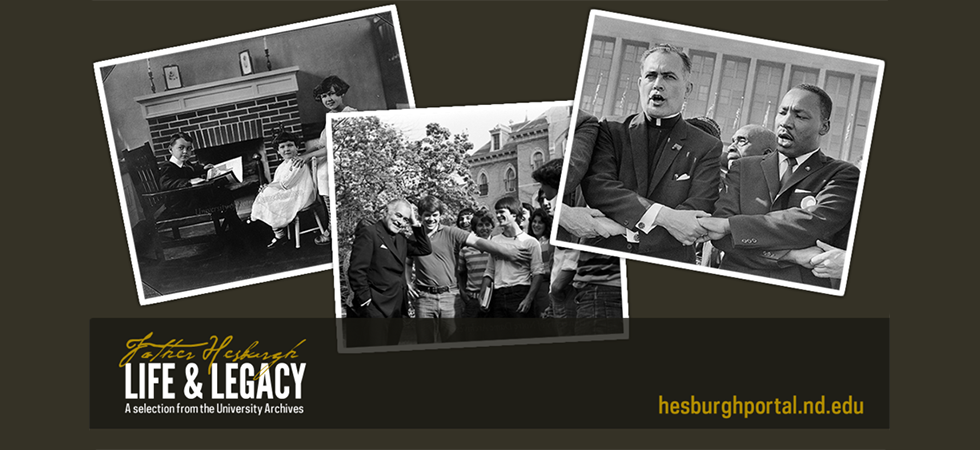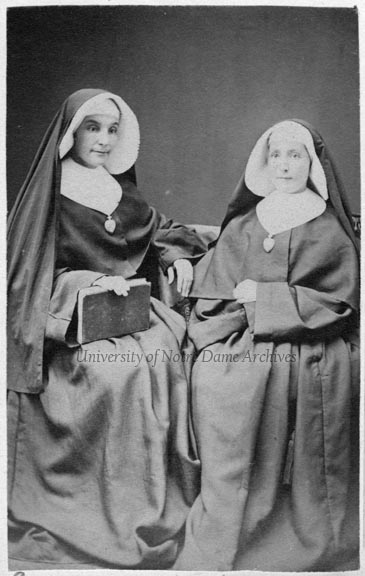
The Women & Spirit: Catholic Sisters in America traveling exhibit stops in South Bend from September 2 – December 31, 2011, at the Northern Indiana Center for History. A number of photographs and audio-visual materials from the Notre Dame Archives make an appearance in this exhibit.
Early in Notre Dame’s history in 1843, four Holy Cross sisters joined founder Rev. Edward Sorin. For over 115 years afterward, they graced the “French Quarter” behind Main Building, now known as the Brownson Hall complex.
 Two unidentified Holy Cross (CSC) Sisters, c1860s-1870s
Two unidentified Holy Cross (CSC) Sisters, c1860s-1870s
The nuns at Notre Dame were entrenched in university life from 1843-1958. “They staffed the laundries, infirmaries, kitchens, and St. Edwards’ Minims School. There was hardly a facet of Notre Dame life they did not influence. They set type in the University Press offices located just east of the rear of Brownson Hall, bound books and periodicals, and deciphered mysterious chirography in manuscripts which baffled the editors. They were tailors, nurses, gardeners, seamstresses, cooks, and charwomen for thousands of Notre Dame priests, brothers, lay faculty and students. Beginning with only 4 sisters, their numbers grew to 140, then dwindled to only 14 in 1958″ [Schlereth, page 45].
 Mass of thanksgiving in the Holy Cross Sisters’ convent chapel, 1958/0504.
Mass of thanksgiving in the Holy Cross Sisters’ convent chapel, 1958/0504.
Caption: “Rev. Arthur Hope, CSC (right), author of Notre Dame: 100 Years, preaches at a Solemn High Mass May 4th marking the departure of virtually all the Holy Cross nuns from the campus after 115 years of devoted service to the University. Pope Pius XII sent his congratulations and apostolic blessing to the Sisters who vacated the campus convent and returned to their mother-house at St. Mary’s College the following day. in earlier years more than 100 Holy Cross nuns served Notre Dame in many capacities. Only five nuns will remain to care for altar linens and staff the student infirmary.”
In its mission to collect, maintain, and preserve records that document the life of the Catholic Church and her people as lived in the American context, the Notre Dame Archives houses a number of collections regarding religious women from various congregations, organizations, and individuals. Among the larger collections are those of the National Assembly of Religious Women (US), the Leadership Conference of Women Religious of the United States, Sr. Marie Augusta Neal, and the Poor Handmaids of Jesus Christ.
 Conference of Major Superiors of Women (CMSW), later Leadership Conference of Women Religious (LCWR), August 1963
Conference of Major Superiors of Women (CMSW), later Leadership Conference of Women Religious (LCWR), August 1963
Sources:
University of Notre Dame: Portrait of History and Campus by Thomas J. Schlereth
GSBA 3/15
GPHR 45/3464
GLCW




 Two unidentified Holy Cross (CSC) Sisters, c1860s-1870s
Two unidentified Holy Cross (CSC) Sisters, c1860s-1870s Mass of thanksgiving in the Holy Cross Sisters’ convent chapel, 1958/0504.
Mass of thanksgiving in the Holy Cross Sisters’ convent chapel, 1958/0504.  Conference of Major Superiors of Women (CMSW), later Leadership Conference of Women Religious (LCWR), August 1963
Conference of Major Superiors of Women (CMSW), later Leadership Conference of Women Religious (LCWR), August 1963